
-
Find the right food for your petTake this quiz to see which food may be the best for your furry friend.Find the right food for your petTake this quiz to see which food may be the best for your furry friend.Featured products
 Puppy Food
Puppy FoodHill's Science Plan Puppy Multipack Wet Dog Food with Chicken & Beef are complete premium pet foods for growing puppies from weaning until 1 year old and for pregnant and nursing dogs. Your puppy will love these deliciously smooth and savoury minced loaves, formulated for balanced nutrition and overall health.
Shop Now Adult Wet Dog Food with Beef
Adult Wet Dog Food with BeefHill's Science Plan Adult Multipack Wet Dog Food with Chicken, Beef & Turkey are complete premium pet foods for adult dogs from 1 year. Your dog will love these deliciously smooth and savoury minced loaves, formulated for balanced nutrition and overall health.
Shop Now Mature Adult Dog Food
Mature Adult Dog FoodHill's Science Plan Mature Adult Multipack Wet Dog Food with Chicken & Beef are complete premium pet foods for mature adult dogs from 7 years. Your dog will love these deliciously smooth and savoury minced loaves, formulated to deliver the appropriate amount of energy to support the needs of adult dogs.
Shop NowFeatured products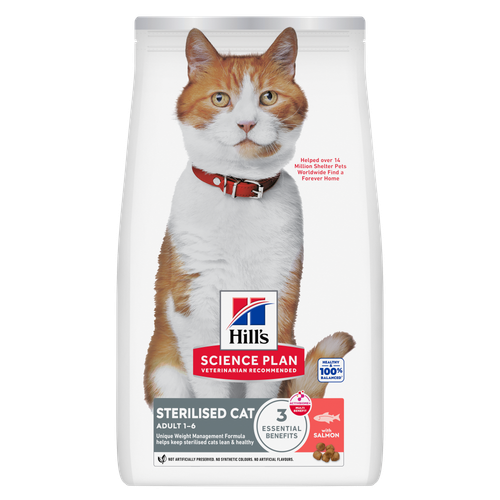 Sterilised Adult Cat Food
Sterilised Adult Cat FoodHill's Science Plan Adult Sterilised Cat Dry Food with Salmon is specially formulated with ActivBiome+ Multi-Benefit Technology. It is a precisely balanced nutrition, tailored to meet the needs of sterilised cats, to help keep them lean & healthy.
Shop Now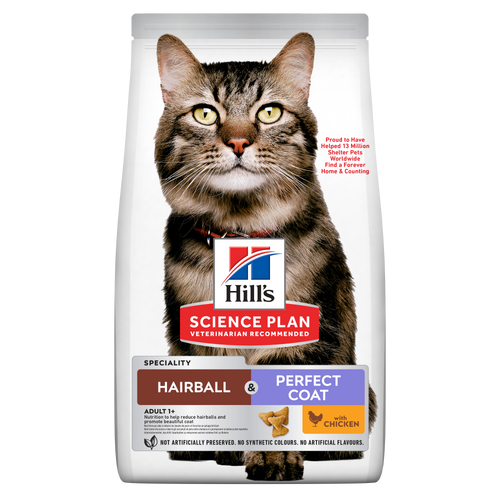 Hairball & Perfect Coat Adult Dry Cat Food with Chicken
Hairball & Perfect Coat Adult Dry Cat Food with ChickenHill's Science Plan Hairball & Perfect Coat Adult Cat Food with Chicken is formulated to effectively help avoid hairball formation in adult cats while promoting a beautiful coat. Thanks to its mix of essential omega-6 fatty acids, this food benefits the cat's skin and fur, keeping them healthy and shiny. Our Advanced Fibre Technology helps reduce hairballs by naturally promoting their passage through the gut. This food is formulated with high-quality protein for a perfectly balanced, great-tasting recipe.
Shop Now Sensitive Stomach & Skin Adult Cat Food
Sensitive Stomach & Skin Adult Cat FoodHill's Science Plan Sensitive Stomach & Skin Adult Wet Cat Food with Turkey is a complete pet food for adult cats, aged 1–6 years. This highly digestible wet food comes in a pouch and supports healthy digestion, as well as nourishes skin and promotes a thick and lustrous coat.
Shop Now -
Dog
- Dog Tips & Articles
-
Health Category
- Weight
- Food & Environmental Sensitivities
- Urinary
- Digestive
- Joint
- Kidney
-
Life Stage
- Puppy Nutrition
- Adult Nutrition
- Senior Nutrition
Cat- Cat Tips & Articles
-
Health Category
- Weight
- Skin & Food Sensitivities
- Urinary
- Digestive
- Kidney
-
Life Stage
- Kitten Nutrition
- Adult Nutrition
Featured articles Show some love with wet foods: a great choice for pets with health issues
Show some love with wet foods: a great choice for pets with health issuesShow some love with wet foods: a great choice for pets with health issues.
Read More Help! My Dog Doesn't Like Me & I Have a Standoffish Cat
Help! My Dog Doesn't Like Me & I Have a Standoffish CatIf you've ever thought to yourself, "My dog doesn't like me," or "Why do I have such a standoffish cat?" rest assured that you aren't the only pet parent who has these concerns.
Read More The Right Diet For Your Pet
The Right Diet For Your PetIn people, the right diet is very important. If you are eating the wrong way for your metabolism, activity level, age and lifestyle you could end up with health issues.
Read More -


Have you noticed that your cat has dry, flaky skin that looks like dandruff? A little bit of dandruff is a normal part of skin shedding, but when it starts to become obvious, it may be that something else is going on.
Cats get a build-up of dandruff for two main reasons. It may be that your cat has a normal amount of dandruff but isn’t grooming it away. Alternatively, they may have an abnormal amount of dandruff because of an underlying cause. Let’s have a look at why this might be happening and what you can do about it.
Lack of normal grooming
Cats are fastidiously clean and should normally spend hours every day grooming themselves and keeping their fur and skin in tip-top condition. There are two main things that are likely to physically get in the way of this: obesity and pain, such as arthritis. If your cat is obese, which is sadly very common these days, they may physically not be able to reach all the places they need to. This will most commonly affect the back end.
The effect of chronic pain on normal grooming will depend on which part of the body is affected. As cats age, many develop arthritis in joints such as the hips, elbows and shoulders. Pain like this makes it difficult to get into the amazing positions that we’re used to seeing our cats achieve, so skin and dead hair flakes will build up.


Tasty Tips
Underlying causes that produce a build-up of dandruff
Allergic skin disease. Cats can be allergic to environmental things (atopic dermatitis) like pollen and grasses, and certain food ingredients.
Parasites. Fleas and certain mites can cause irritation and dandruff build-up. Some mites are contagious to humans, too, so watch out for signs on yourself or the children.
Skin infections, either bacterial or fungal, may cause dandruff.
Other medical issues, such as kidney disease or hyperthyroidism, can cause the condition of the skin and coat to decline.
Malnutrition. If an animal is malnourished, the skin is one of the first things to suffer.
What should you do if your cat has dandruff?
You may not need to do anything except groom your cat more and see if it improves. However, you should contact your vet if your cat:
Seems unwell or their behaviour has changed.
Is grooming excessively.
Is scratching a lot or seems itchy.
Is drinking more than usual.
Is obese.
Is losing fur or has bald patches or scabs.
Is suffering from itchy skin at the same time that you or a member of your family also has itchy skin, as some causes of dandruff in cats can be contagious to humans.
Your vet may want to do some tests to find out the exact cause of the dandruff, and will recommend a treatment depending on the results. It may be that there are parasites or an infection that are easy to treat, or they may find another medical condition that needs addressing. Your vet may also recommend a change of food to rule out a food allergy, or to see if your cat benefits from a food formulated for optimal skin and coat health. These foods have high levels of omega oils and antioxidants, and just the right mineral balance for great skin health, as well as good-quality protein.
In short, a little dandruff is probably nothing to worry about, but if it continues or builds up, then a trip to your vet is always a good idea. It’s always better to be safe than sorry.
Reviewed by Dr. Hein Meyer, DVM, PhD, Dipl-ECVIM-CA


One of our staff authors prepared this article for you
Related products

Hill's Science Plan Hairball & Perfect Coat Adult Cat Food with Chicken is formulated to effectively help avoid hairball formation in adult cats while promoting a beautiful coat. Thanks to its mix of essential omega-6 fatty acids, this food benefits the cat's skin and fur, keeping them healthy and shiny. Our Advanced Fibre Technology helps reduce hairballs by naturally promoting their passage through the gut. This food is formulated with high-quality protein for a perfectly balanced, great-tasting recipe.

Hill's Science Plan Perfect Digestion Cat Food with Chicken & Brown Rice nourishes your cat's unique microbiome and helps them reach their full potential.

Hill's Science Plan Adult Sterilised Cat Dry Food with Salmon is specially formulated with ActivBiome+ Multi-Benefit Technology. It is a precisely balanced nutrition, tailored to meet the needs of sterilised cats, to help keep them lean & healthy.

Hill's Science Plan Sensitive Stomach & Skin Adult Wet Cat Food with Turkey is a complete pet food for adult cats, aged 1–6 years. This highly digestible wet food comes in a pouch and supports healthy digestion, as well as nourishes skin and promotes a thick and lustrous coat.
Related articles

There are three common ways to feed a cat. Each way has its advantages and disadvantages.
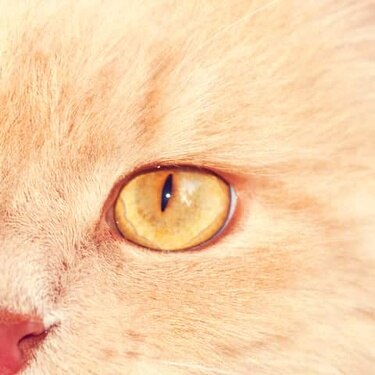
Chocolate is known to be poisonous for dogs, but it can also be toxic for cats. Learn why chocolate is bad for cats & what to do if she's eaten it.
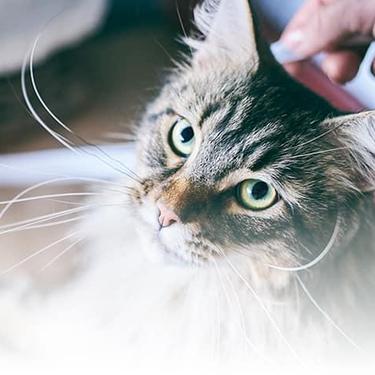
Learn how to make homemade cat treats that are healthy for your pet with this recipe from Hills Pet Nutrition.
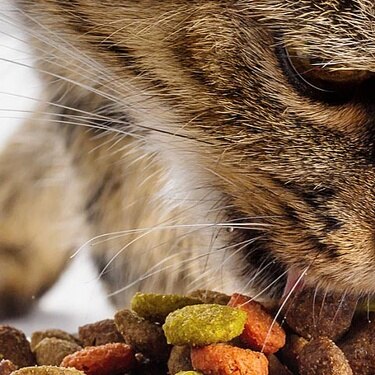
From essential vitamins & minerals to different types of meat, learn what to look for when choosing the best cat food for your feline.

Put your cat on a diet without them knowing
Our low calorie formula helps you control your cat's weight. It's packed with high-quality protein for building lean muscles, and made with purposeful ingredients for a flavourful, nutritious meal. Clinically proven antioxidants, Vitamin C+E, help promote a healthy immune system.
Put your cat on a diet without them knowing
Our low calorie formula helps you control your cat's weight. It's packed with high-quality protein for building lean muscles, and made with purposeful ingredients for a flavourful, nutritious meal. Clinically proven antioxidants, Vitamin C+E, help promote a healthy immune system.

